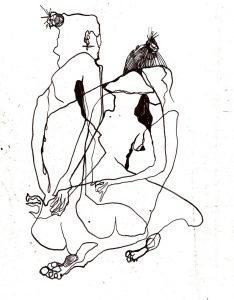Paradox (Upd: Nov 12, ’22)
A deaf midwife hears a morgue’s stone window opening shut as her white satin shadow waves frozen despite the black sun rising to dusk with a wingless dove flying inside out into a parched puddle reminiscing tomorrow’s threadless spool under a missing chandelier. (From my piece entitled Excerpt from an Endless Codex)

A paradox is something that bears contradictory elements. Sometimes paradox is connected to irony. Geoffrey Harpham has connected paradox with the grotesque because of its living in the fringe or the interval (or gap). Geoffrey Harpham notes:
“If the grotesque can be compared to anything, it is to paradox. Paradox is a way of language against itself by asserting both terms of a contradiction at once. Pursued for its own sake, paradox can seem vulgar or meaningless; it is extremely fatiguing to the mind. But pursued for the sake of wordless truth, it can rend veils and even, like the grotesque, approach the holy.¹
Hence paradox is connected to liminality/ma. It is also connected to the non-dual realm.
Both Helena Katinkoski and Jochelle Elise Pereña propose that paradox is the one thing that separates Butoh from other art forms. Katinkoski claims butoh to be “a liminal art that arrives to non-dual performing by embodiment of a paradox,”3 and similarly, Pereña claims that “[Butoh] is a liminal art, meaning that it is part of the threshold or limen between worlds, and it is also part of both worlds – a paradox.”4 “Bipolar oppositionalism” coined by Arata Isozaki is what Katinkoski feels Hijikata based his butoh on such as death being life and ugly being beautiful.5
Koans often exhibit paradox.
Here are some examples of qualities that may be somehow embodied, perhaps after discovering a sense of false dichotomy: fast and slow; small and large; light and heavy; young and old; airy and solid; strong and weak; strange and normal; beautiful and ugly; vain and humble; pleasurable and painful; cold and hot; rough and smooth; rainy and sunny; silent and loud; bitter and sweet; sunny and rainy; happy and sad; something and nothing; nowhere and everywhere.
Exercise 1: Countervaporization Paradox (Advanced)
This is an exercise in opposition and paradox. This is a form of conjoining opposites. Here are some examples: If you are physically in a constrained body, your astral body or invisible world body is countervaporizing that of expansion. If you feel heavy, then the countervaporization is light. This means that though externally you may embody a certain qualia, internally (in the vaporized world), you are embodying the opposite.
Example Characters
The title alone describes their paradox: (1) happy monster; (2) beggar king; (3) mute Soprano; (4) old baby; (5) happy scrooge; (6) enlightened creature; (7) sick bodybuilder; (8) beauty pageant creature; (9) sleepy jogger; (10) lobotomized philosopher*; (11) nudist Catholic nun.
Rituals/Psychodramas
Immovable Force vs Unstoppable Object
Paradoxes of Butoh
One of the perspectives of what distinguishes butoh from the rest of the arts is its use of paradox. Butoh can be:
- Ugly yet beautiful
- Debilitated yet lively
- Obscure yet expressive
- Genius yet amateur
Stephen Wangh’s Paradoxes of Acting
Stephen Wangh was a pupil of Jersy Grotowski who expressed the following paradoxes of acting:6
- One must have fun but be serious at the same time.
- One must be in control and out of control (free) at the same time.
- One must give equal attention to the internal world and external world. (In this manual, this is called 50% inside, 50% outside.)
- There is no separation between ego/exhibitionism and offering/compassion.
- We must experience being the actor/identity and character at the same time.
Confusion
We can utilize confusion to enter into new and unfamiliar territory. Anything dealing with paradox especially can lead into a state of confusion. Cognitive dissonance also leads to confusion and occurs when one is between two or more contradicting beliefs.
Exercise: Contradictory Suggestions
This exercise can be done with one or more speakers throwing out contradictory suggestions. The more contradictory, the better. It begins with visualizations of the suggestions, e.g. we fly, and the ground is hot. Summer is cold, and we go inside. Here, we go outside. Inside we stay heavy like a feather. Once the acting participant is in an overwhelming state, all suddenly stops with a final suggestion that is to make clear sense:
Example suggestions: (1) Now dance your mystery; (2) Now enter into your true self; (3) Now resonate with one thing.
The point of the exercise is to enter into trance so that profundity in the subbody can be found. This exercise is based in Milton Erickson’s confusion technique.²